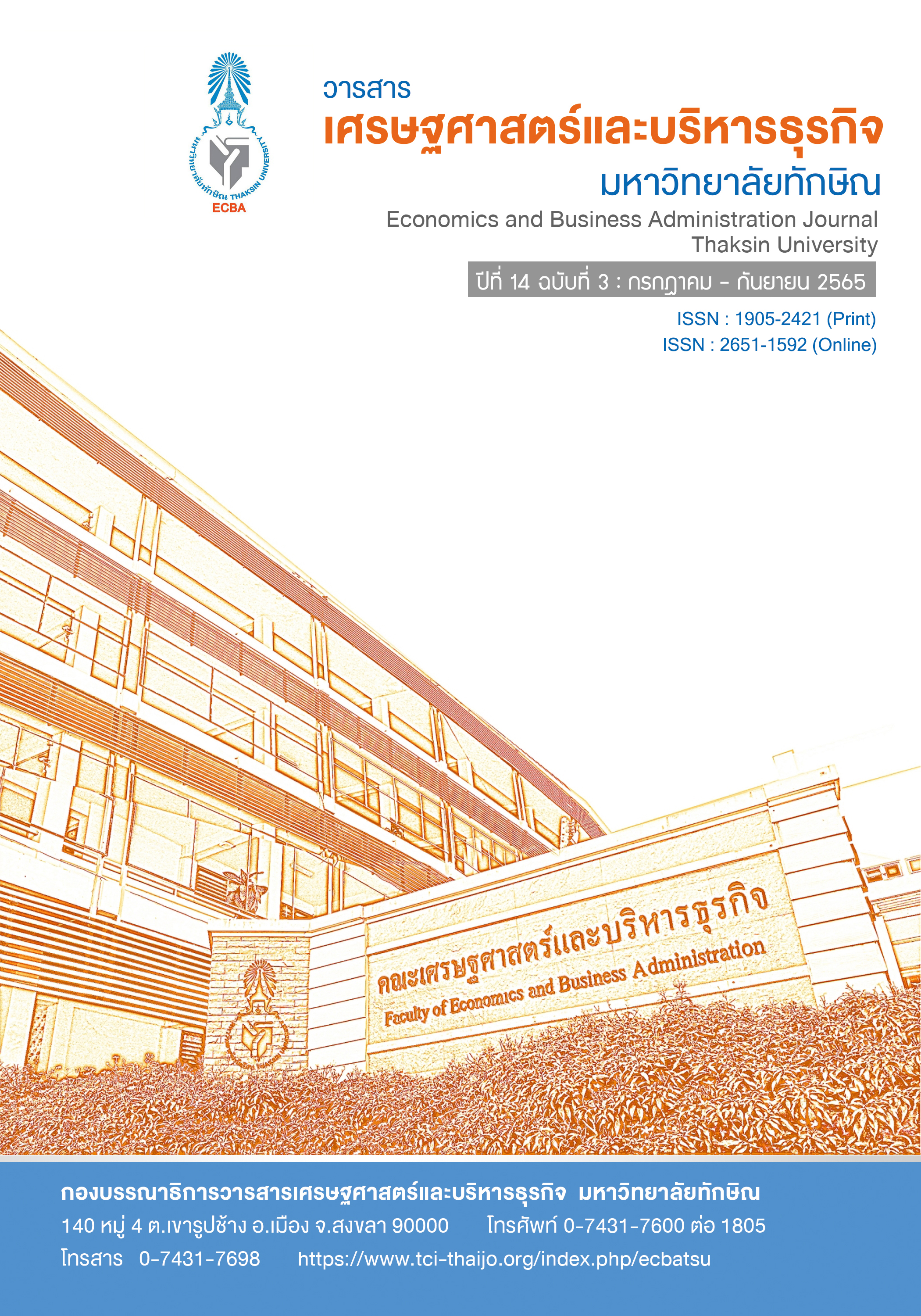การประเมินมูลค่าความเสียหายจากการละเมิดข้อมูลส่วนบุคคล: กรณีศึกษาในเขตกรุงเทพมหานครและปริมณฑล
คำสำคัญ:
การละเมิดข้อมูลส่วนบุคคล, ความเต็มใจจ่าย, เทคนิคสมมติเหตุการณ์ให้ประเมินค่าบทคัดย่อ
การศึกษาในครั้งนี้มีวัตถุประสงค์ (1) เพื่อประเมินมูลค่าความเสียหายจากการละเมิดข้อมูลส่วนบุคคล โดยอาศัยเครื่องมือทางเศรษฐศาสตร์ เทคนิคสมมติเหตุการณ์ให้ประเมินค่า (Contingent Valuation Method) และวิเคราะห์สมการถดถอย แบบจำลอง Censored Regression Model เพื่อประเมินมูลค่าความเต็มใจจ่ายเพื่อความเป็นส่วนตัวและความปลอดภัยของข้อมูลส่วนบุคคล และ (2) เพื่อวิเคราะห์ปัจจัยที่มีอิทธิพลต่อความเต็มใจจ่ายของกลุ่มตัวอย่างจำนวน 549 ตัวอย่าง ที่อาศัยอยู่ในพื้นที่กรุงเทพมหานครและปริมณฑล ผลการศึกษาพบว่า ความเต็มใจจ่ายเพื่อความเป็นส่วนตัวและความปลอดภัยของข้อมูลส่วนบุคคลอยู่ที่ 2,390.66 บาทต่อคนต่อปี เมื่อคำนวณมูลค่าความเสียหายจากเหตุการณ์การละเมิดข้อมูลส่วนบุคคลของผู้ใช้บริการธุรกิจพาณิชย์อิเล็กทรอนิกส์ในประเทศไทย ช่วงเดือนพฤศจิกายน 2563 พบว่าเหตุการณ์ดังกล่าวก่อให้เกิดความเสียหายทางเศรษฐกิจ รวมมูลค่าสูงถึง 31,078.56 ล้านบาท โดยราคาที่เสนอครั้งแรก อายุ สถานภาพสมรส รายได้ รายจ่ายด้านการติดต่อสื่อสาร ความรู้ความเข้าใจเกี่ยวกับข้อมูลส่วนบุคคล ประสบการณ์การถูกละเมิดข้อมูลส่วนบุคคล การให้ความสำคัญกับความเป็นส่วนตัวของข้อมูลส่วนบุคคล และการรับรู้ความเสี่ยงจากการเปิดเผยข้อมูลส่วนบุคคล มีความสัมพันธ์กับความเต็มใจจ่ายอย่างมีนัยสำคัญทางสถิติ
เอกสารอ้างอิง
Acquisti, A., John, L. K., & Loewenstein G. (2013). What Is Privacy Worth?. The Journal of Legal Studies, 42(2), 249-274.
Bangkok Herald. (2020). Lazada blames tech partner for hackers stealing 13 million Thailand data records. Retrieved from https://bangkokherald.com/business/tech/lazada-blames-tech-partner-for-hackers-stealing-13-million-thailand-data-records/
Beresford, A. R., Kübler, D., & Preibusch S. (2012). Unwillingness to pay for privacy: A Field Experiment. Economics Letters, 117(1), 25-27.
Blythe, J. M., Johnson, S. D., & Manning, M. (2020). What is security worth to consumers? Investigating willingness to pay for secure Internet of Things devices. Crime Science, 9(1), 1-9.
Cameron, T. A. (1988). A New Paradigm for Valuing Non-market Goods Using Referendum Data: Maximum Likelihood Estimation by Censored Logistic Regression. Journal of Environmental Economics and Management, 15(3), 355-379.
Carrière-Swallow, Y., & Haksar, V. (2019). The Economics of Data (IMF Publication No. 19/16). Retrieved from https://blogs.imf.org/2019/09/23/the-economics-of-data/
Hanemann, W. M. (1984). Welfare evaluations in contingent valuation experiments with discrete responses. American Journal of Agricultural Economics, 66(3), 332–341.
Lee, S. Y., Chung, J. H., & Lee, J. S. (2015). A study on the damage costs for private information leakage using the contingent valuation method. In Brebbia, C. A. (Ed.), Sustainable Development. (p. 1249-1258). United Kingdom: Wessex Institute of Technology.
Skatova, A., McDonald, R. L., Ma, S., & Maple, C. (in press). Unpacking Privacy: Willingness to pay to protect personal data. PsyArXiv.
Trachtenbarg, D. E., Asche, C., Ramsahai, S., Duling, J., & Ren, J. (2017). The benefits, risks and costs of privacy: patient preferences and willingness to pay. Current Medical Research and Opinion, 33(5), 845-851.
Wannitikul, K. (2002). Environmental Economics (2nd ed.). Nonthaburi: Sukhothai Thammathirat Open University
World Economic Forum. (2020). The Global Risks Report 2020. Retrieved from http://www3.weforum.org/docs/WEF_Global_Risk_Report_2020.pdf
You, S. D., & Yoo, J. (2014). Determinants of Willingness To Pay for Personal Information Protection. Journal of the Korea Institute of Information Security & Cryptology, 24(4), 695-703.
ดาวน์โหลด
เผยแพร่แล้ว
รูปแบบการอ้างอิง
ฉบับ
ประเภทบทความ
สัญญาอนุญาต
ลิขสิทธิ์ (c) 2022 วารสารเศรษฐศาสตร์และบริหารธุรกิจ มหาวิทยาลัยทักษิณ

อนุญาตภายใต้เงื่อนไข Creative Commons Attribution-NonCommercial-NoDerivatives 4.0 International License.




